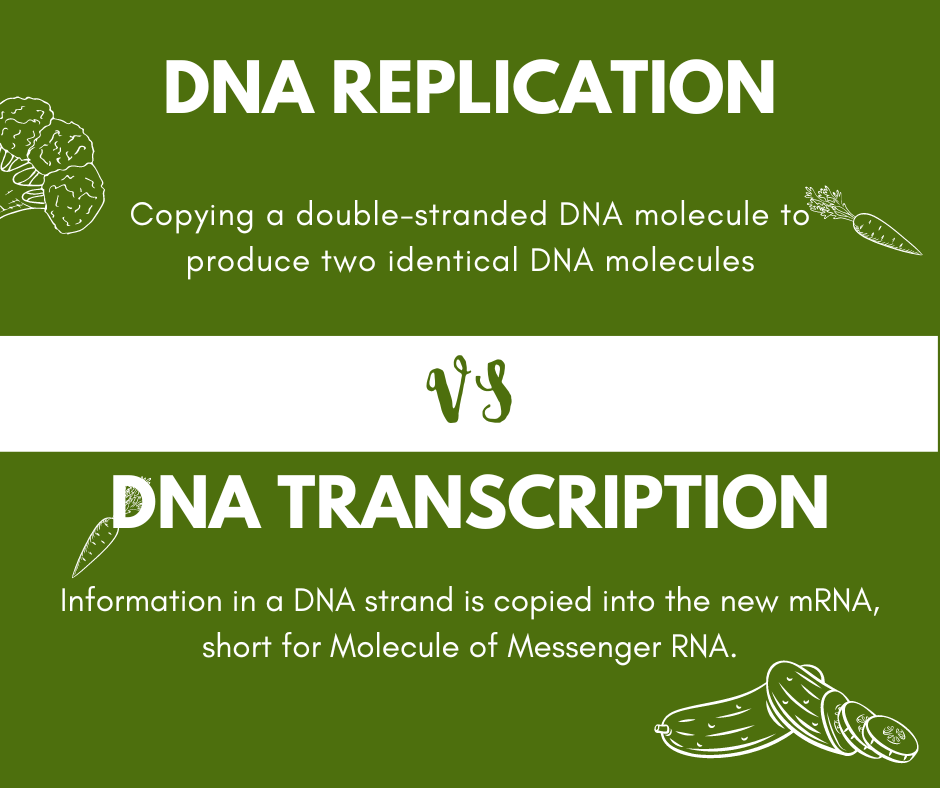DNA Transcription Vs DNA replication
Cell division plays a crucial role in the growth of an organism. The division of a cell happens when the cell replicates the DNA in its genome (a complete set of genetic information in an organism comprising all the information it requires to function). As a result, the parent cell produces two daughter cells containing the same genetic information as the parent cell.
The role of both DNA replication and transcription is to generate a new molecule of nucleic acid (DNA or RNA). However, the function of DNA replication and transcription is different, with one involved in cell division and the other being a part of gene expression.
DNA replication and transcription help in binding complementary nucleotides into DNA, producing new DNA and RNA strands, respectively. When DNA replication happens, it produces two-strand replicas of the whole genome, which is highly crucial for cell division. Meanwhile, transcription lays the path for gene expression to build the necessary protein for the cell to function.
The critical difference is that DNA replication aims to create a replica of the genome. In contrast, transcription involves transferring genetic information of a particular segment of DNA into RNA.
What is DNA Replication?
DNA replication is copying a double-stranded DNA molecule to produce two identical DNA molecules. The two new daughter cells must contain the same genetic information or DNA as the parent cell. This is because each strand of DNA serves as a template for further duplication.
The point at which the DNA replication is initiated is known as Origins. In this phase, the DNA double helix unwound, synthesizing a short RNA segment (primer), which acts as starting point of new DNA synthesis.
Next comes DNA polymerase, an enzyme replicating the DNA, ensuring its bases match the original strand. The RNA primer is later replaced with DNA after the completion of the synthesis process. Any gaps between the newly synthesized DNA segments are sealed with enzymes.
The cell proofreads the newly synthesized DNA, ensuring no mutation or mistakes have occurred during the process. Once the DNA is replicated precisely as intended, it divides into two cells containing identical copies of the original DNA.
What is DNA transcription?
DNA transcription is a process where the information in a DNA strand is copied into the new mRNA, short for Molecule of Messenger RNA.
DNA can store genetic material in the nuclei of cells as a reference or template in a safe and stable manner. The same cannot be said for mRNA. Although mRNA carries the same information as DNA, it cannot store information for a long time and can exit the nucleus freely.
Therefore, we cannot consider mRNA an identical copy of the DNA segment as its sequence is complementary to the DNA template.
The process of transcription
- It is carried out by RNA polymerase enzyme and specific accessory proteins known as transcription factors.
- Transcription factors start binding with specific DNA sequences known as enhancer and promoter sequences for recruiting RNA polymerase to the right transcription site.
- The transcription factors and RNA polymerase form a complex known as the transcription initiation complex to initiate transcription.
- Then the RNA polymerase matches complementary bases to the original DNA strand to start the mRNA synthesis.
- The mRNA molecule gets elongated in the process, and once the strand fully synthesizes, the transcription is terminated.
- The newly formed mRNA copies serve as blueprints for protein synthesis for the translation process.
Difference between DNA replication and transcription
| Factors | Replication | Transcription |
| Definition | replication of one strand of DNA into two daughter stands with each daughter strand containing half the DNA of the original double helix. | production of several functional RNA using genes as template. |
| Purpose | to conserve the genome for next generation. | to produce RNA copies of genes individually. |
| Products created | It creates two daughter strands of DNA. | The products are mRNA, tRNA, rRNA and non-coding RNA. |
| Processing | It is processed in eukaryotes when base pair nucleotides bond with the sense or antisense strand, further connected with phosphodiester bonds by DNA helix to form a complete strand. | 5’ cap and 3’ poly A tail is added followed by splicing the introns. |
| Occurrence | In the S phase of cell cycle. | In the G1 and G2 phase of cell cycle. |
| Primer | requires RNA primer to initiate the replication process. | does not require a Primer. |
| Enzymes involved | DNA polymerase and DNA helicase. | RNA polymerase and Transcriptase. |
| Genome copy | Entire genome is copied | Only certain genome are copies. |
| Degradation | Products do not degrade as they remain within nucleus. | They degrades as greater parts of the products passes from nucleus into cytoplasm when their function ends. |
| Base Pairing | It comprises 4 bases with three letter combinations, providing a possibility of 64 codons in total 43 combinations. | The enzyme creates a complementary strand by finding the correct base through complementary base paring and bonding with the original strand. |
Conclusion
Both DNA replication and transcription generates a new copy of DNA in a cell. While DNA replication make an exact copy of DNA, DNA transcription replicates the DNA into RNA. Both are involved in producing new nucleic acids- DNA or RNA. The newly produces nucleic acids may have some similarities, but differs in functions. For instance, one may carry cell division while other focus on gene expression.







